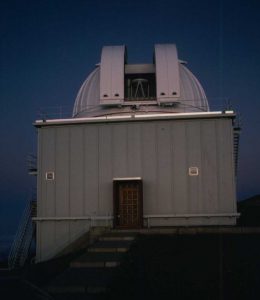
TUSCALOOSA, Ala. — University of Alabama faculty and student astronomers are gaining remote access to a telescope on one of the Canary Islands, off Africa’s coast.
Starting in 2015, UA astronomers may access the remotely operated 1.0-m Jacobus Kapteyn Telescope on the Spanish Canary Island of La Palma, which is off the coast of Morocco.
“It’s very different in longitude from our current most northern telescope at Kitt Peak, so it’s dark there at different times,” said Dr. William Keel, UA professor of astronomy. “So, if someone is studying a pulsating star, for example, you could follow that star uninterrupted for 18 hours.”
Having access to a nighttime sky during daylight hours in Tuscaloosa also opens more teaching opportunities during traditional class times, Keel said.
UA will acquire access to the telescope through its participation in an 11-member consortium known as the Southeastern Association for Research in Astronomy. The consortium, known as SARA, is comprised of UA and 10 other institutes of higher education with similar goals for the education of astronomy and astrophysics students.
The telescope, situated at an altitude of 2,360 meters at the Observatorio del Roque de los Muchachos, has sat idle since 2003. In late 2011, the Science and Technology Facilities Council of the United Kingdom invited submission of proposals to take over telescope operations.
Daniel Batcheldor, assistant professor of physics and space sciences at Florida Tech, led a team of SARA astronomers on negotiating for the handover of telescope operations and securing funding from the National Science Foundation to acquire the equipment to convert the telescope to a remote observatory.
In July, the NSF decided to fund the $474,000 project through its Major Research Instrumentation Program.
SARA remotely operates a 0.9-m telescope at Kitt Peak National Observatory in Arizona and a 0.6-m telescope at Cerro Tololo Inter-American Observatory in Chile.
SARA representatives will revisit the telescope site in December to finalize plans for installing the remote observation equipment. Testing the system will take place during fall 2014, with an anticipated operational date of January 2015.
Operating a telescope in this part of the world also opens pathways for further international collaborations, Keel said.
UA’s department of physics and astronomy is part of The College of Arts and Sciences, the University’s largest division and the largest liberal arts college in the state. Students from the College have won numerous national awards including Rhodes Scholarships, Goldwater Scholarships and memberships on the USA Today Academic All American Team.
Contact
Chris Bryant, UA media relations, 205/348-8323, cbryant@ur.ua.edu
Source
Dr. William Keel, wkeel@as.ua.edu